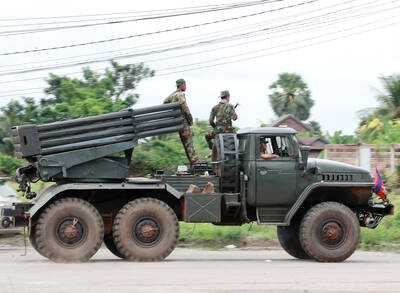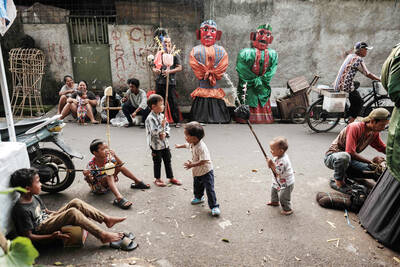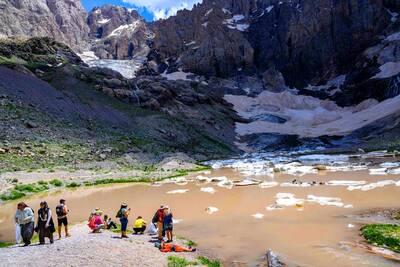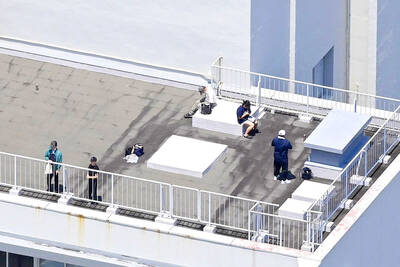An Australian scientist launched what he called a “reef and beef” study yesterday into whether feeding cows seaweed would reduce their flatulent carbon emissions, in a move that could help save the Great Barrier Reef.
Tony Parker, from James Cook University, said cattle produced up to 20 percent of global man-made methane emissions, and the problem was largely linked to their diet.
“Seaweed, algae and other sea grasses have been proven to be much more digestible than land grass because they have less cellulose and more starch,” Parker’s research partner Rocky de Nys said. “A better diet for cattle, then, will encourage better digestion and thus lead to a decrease in methane emissions.”
Methane gas from livestock accounts for about 12 percent of Australia’s annual greenhouse emissions, with flatulence from 120 million sheep, cows and goats comprising its third-largest source of damaging gases.
The average beef cow expels the equivalent of around 1,500kg of carbon per year.
The scientists said that using seaweed as cattle fodder could also have wider benefits for the environment, by providing coastal farmers with a way to clean waterways that flowed into the Great Barrier Reef.
Seaweed could be used to clear nitrogen and phosphorous from farming water, but few farmers adopted the method because they were left with “a huge biomass that they don’t know what to do with,” De Nys said.
He said those nutrients were partly responsible for the breakdown of aquatic ecosystems within the iconic Barrier Reef, which authorities warned this week faced significant threats from climate change and farming runoff.
“I like to call it the ‘reef and beef’ project because it has far reaching implications that come full circle: starting with seaweed, taking in the beef and aquaculture industries and extending back out to the sea to help conserve the Great Barrier Reef,” Parker said.

POLITICAL PATRIARCHS: Recent clashes between Thailand and Cambodia are driven by an escalating feud between rival political families, analysts say The dispute over Thailand and Cambodia’s contested border, which dates back more than a century to disagreements over colonial-era maps, has broken into conflict before. However, the most recent clashes, which erupted on Thursday, have been fueled by another factor: a bitter feud between two powerful political patriarchs. Cambodian Senate President and former prime minister Hun Sen, 72, and former Thai prime minister Thaksin Shinawatra, 76, were once such close friends that they reportedly called one another brothers. Hun Sen has, over the years, supported Thaksin’s family during their long-running power struggle with Thailand’s military. Thaksin and his sister Yingluck stayed

In the sweltering streets of Jakarta, buskers carry towering, hollow puppets and pass around a bucket for donations. Now, they fear becoming outlaws. City authorities said they would crack down on use of the sacred ondel-ondel puppets, which can stand as tall as a truck, and they are drafting legislation to remove what they view as a street nuisance. Performances featuring the puppets — originally used by Jakarta’s Betawi people to ward off evil spirits — would be allowed only at set events. The ban could leave many ondel-ondel buskers in Jakarta jobless. “I am confused and anxious. I fear getting raided or even

Kemal Ozdemir looked up at the bare peaks of Mount Cilo in Turkey’s Kurdish majority southeast. “There were glaciers 10 years ago,” he recalled under a cloudless sky. A mountain guide for 15 years, Ozdemir then turned toward the torrent carrying dozens of blocks of ice below a slope covered with grass and rocks — a sign of glacier loss being exacerbated by global warming. “You can see that there are quite a few pieces of glacier in the water right now ... the reason why the waterfalls flow lushly actually shows us how fast the ice is melting,” he said.

Residents across Japan’s Pacific coast yesterday rushed to higher ground as tsunami warnings following a massive earthquake off Russia’s far east resurfaced painful memories and lessons from the devastating 2011 earthquake and nuclear disaster. Television banners flashed “TSUNAMI! EVACUATE!” and similar warnings as most broadcasters cut regular programming to issue warnings and evacuation orders, as tsunami waves approached Japan’s shores. “Do not be glued to the screen. Evacuate now,” a news presenter at public broadcaster NHK shouted. The warnings resurfaced memories of the March 11, 2011, earthquake, when more than 15,000 people died after a magnitude 9 tremor triggered a massive tsunami that